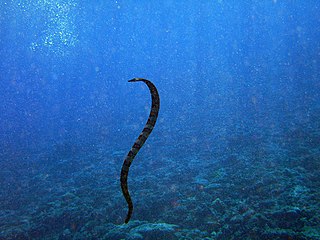 W
WThe black-banded sea krait, also known commonly as the Chinese sea snake, is a species of venomous snake in the subfamily Laticaudinae of the family Elapidae. In Japan it is known as erabu umi hebi (ja:エラブウミヘビ), and in Okinawa as the irabu. It is found in most of the warm waters of the western Pacific Ocean.
 W
WThe blue-lipped sea krait, blue-banded sea krait, or common sea krait is a species of venomous sea snake in the subfamily Laticaudinae, family Elapidae. It is found in the Indian and Western Pacific Oceans.
 W
WCrocker's sea snake is a species of venomous snake in the subfamily Hydrophiinae. The species L. crockeri is found in Oceania.
 W
WThe katuali or flat-tail sea snake is a species of venomous sea snake in the family Elapidae. The species is found only in the waters of the Pacific Islands nation of Niue.
 W
WThe New Caledonian sea krait is a species of venomous snake in the subfamily Hydrophiinae of the family Elapidae. The species is native to the waters around New Caledonia.
 W
WSea kraits are a genus of venomous elapid sea snakes, Laticauda. They are semiaquatic, and retain the wide ventral scales typical of terrestrial snakes for moving on land, but also have paddle-shaped tails for swimming. Sea kraits are often confused with another group of aquatic reptiles, the sea snakes. However, unlike the fully aquatic ovoviviparous sea snakes, sea kraits are oviparous and must come to land to digest prey and lay eggs. They also have independent evolutionary origins into aquatic habitats, with sea kraits diverging earlier from other Australasian elapids. Thus, sea kraits and sea snakes are an example of convergent evolution into aquatic habitats within the Hydrophiinae snakes. Sea kraits are also often confused with land kraits , which are not aquatic.
 W
WThe yellow-lipped sea krait, also known as the banded sea krait, colubrine sea krait, is a species of venomous sea snake found in tropical Indo-Pacific oceanic waters. The snake has distinctive black stripes and a yellow snout, with a paddle-like tail for use in swimming.